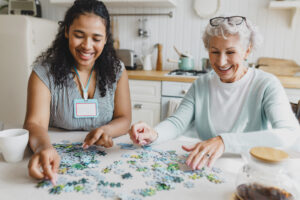When Gail called up her daughter Jan to say that handling the daily responsibilities of the family home on her own had gotten to be too much, it marked a major turning point. She had not only raised her four kids in that house, she had grown up there herself. Jan and her three brothers had approached their mother a few times about moving in with one of them, but she hadn’t been ready to give up a place of her own—and the place that held an entire lifetime of memories.
Many of our aging loved ones struggle with the idea of moving out of the homes they’ve cared for, and that have cared for them—even if family members are waiting with open arms to offer their own houses for in-home care. Whether due to greater physical, cognitive, or financial challenges, a move is more than just an inconvenience for many older adults. As Gail describes, “That wardrobe will be too big to take with me. When I look at it, I can remember the kids playing hide-and-seek in there. And my husband Peter used to leave me notes in the drawers when he would leave early to go into work.”
The process of moving is as much about what our aging loved ones will be leaving behind, as it is about what items they will bring along with them into their new space. It requires a goodbye. It requires a grieving process. You can support your aging loved one through this transition and grief by honoring the pain of their loss, while helping them to stay connected to their interests, their community, and their memories.
Supporting Emotions During the Move
Involving the entire family in the move is best, if possible. In this way, the family can continue to care for the home and its memorable elements—as your aging loved one has done for decades—even during the moving process.
If you do need to bring in outside, professional help, be sure not to disappear, either physically or emotionally. Make sure your aging loved one has someone to talk to and to share difficult feelings with throughout the transition, which has the potential to feel impersonal and methodical.
Accepting Uncomfortable Feelings of Grief
This move may be an immense emotional challenge for your aging loved one. Try not to downplay their experience. Instead, make space for the feelings and conversations around it. Talk about the move in a positive way, but also be willing to talk about the past and allow for your loved one’s grief.
In fact, they may experience depression as a result of the move, which can affect their appetite, their sleep, their energy, and their ability to feel interested in and engaged with things and people around them. Make sure you keep the lines of communication open so your aging loved one doesn’t have reason to feel further isolated.
Remember that both depression and grief are very natural parts of life—and very natural parts of aging. While you may not be able to understand all of their feelings and experiences in this life stage, you can keep them company. Listen and encourage them to share with you. Encourage them to have self-compassion and not to reject the difficult feelings. Their home was an important part of their past, just like the loved ones they have lost, and grief is the way they continue to identify with, and honor, their memories.
Memories Not Contained in Moving Boxes
You can help your loved one connect to their grief so that they can also move beyond it. If they’re moving in with you or another family member, you have the advantage of being able to get creative with the space you’ll share to make way for some of the memories that were strong in the old family home.
If there were family photos displayed in the old house, be sure to bring those over to display in the new space, or it may help to find some, frame them, and hang them for your loved one. It’s good for them to be reminded that moving on from the home they love does not mean they have to move on from everything and everyone they love—and that they don’t have to do it alone.
Stay Connected with Community
If you’re within driving distance of the old neighborhood, make sure your aging loved one still has opportunities to connect with the friends and community they’ve been a part of. If there’s a way to bring friends to the home you now share together, hosting a simple brunch can be a great way for the new arrangement to begin to feel like home. If you’re too far for visits, don’t ignore that personal loss. Perhaps your loved one can write letters to their now distant friends, or call them up on the phone.
Honor Their Need for Purpose and Independence
With the move, not only is your aging loved one losing their beloved home, but they’re also losing some of their independence. They may even feel as if they’re losing some control over themselves, their personal space, and their choices.
Try not to overcompensate for the care that they now need in your home. It’s important that they still feel a sense of purpose—whether that’s limited to their own personal care, or extends to ways they can help you in the home with cleaning, cooking, or maybe playing and reading with the kids. Or, you may even want to encourage them to get involved and be of service to the wider community.
Be Active and Make New Memories
Similarly, it’s important that your aging loved one has continued opportunities to be active—both for their physical and their emotional health. In the midst of their grief, they may experience lower energy levels and less desire to engage with life in ways they had previously done. So, take walks and experience the sunshine and fresh air together. If they were active in the community before the move, do your best to support their continued involvement.
How did the family used to spend time together in your aging loved one’s home—what pastimes did you share? Find ways to bring those activities into the new space. Chances are good that you and your aging loved one now have access to much more quality time than you did before. Enjoy it, and you’ll both have plenty of opportunities to make new memories.
As your aging family member moves out of the home they’ve loved, they can experience a great deal of pain and grief, but it can also be a great time of connection and renewal. As you support them in moving forward, help them to also stay connected to what came before: the relationships, the activities, the memories. They are saying goodbye to a home, and that shouldn’t be taken lightly, but they are also saying hello to a new phase, a new chance to connect with you, and a new opportunity to grow.
If you’re unsure of how to best support your aging loved one during a move or other transition, Institute on Aging offers compassionate services, programs, and resources for you to explore. To learn more, reach out to us today.







